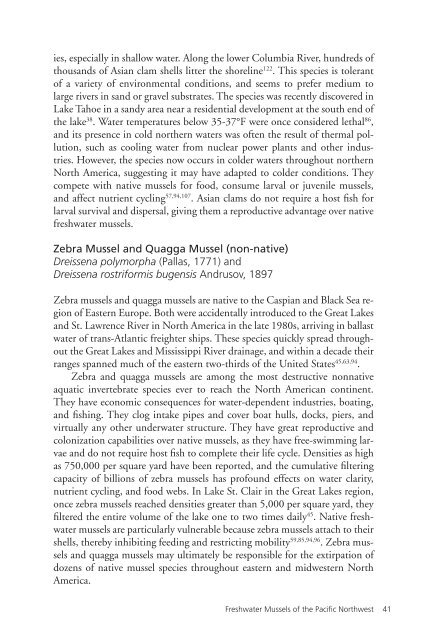Freshwater Mussels Pacific Northwest - The Xerces Society
Freshwater Mussels Pacific Northwest - The Xerces Society
Freshwater Mussels Pacific Northwest - The Xerces Society
Create successful ePaper yourself
Turn your PDF publications into a flip-book with our unique Google optimized e-Paper software.
ies, especially in shallow water. Along the lower Columbia River, hundreds of<br />
thousands of Asian clam shells litter the shoreline 122 . This species is tolerant<br />
of a variety of environmental conditions, and seems to prefer medium to<br />
large rivers in sand or gravel substrates. <strong>The</strong> species was recently discovered in<br />
Lake Tahoe in a sandy area near a residential development at the south end of<br />
the lake 38 . Water temperatures below 35-37°F were once considered lethal 86 ,<br />
and its presence in cold northern waters was often the result of thermal pollution,<br />
such as cooling water from nuclear power plants and other industries.<br />
However, the species now occurs in colder waters throughout northern<br />
North America, suggesting it may have adapted to colder conditions. <strong>The</strong>y<br />
compete with native mussels for food, consume larval or juvenile mussels,<br />
and affect nutrient cycling 57,94,107 . Asian clams do not require a host fish for<br />
larval survival and dispersal, giving them a reproductive advantage over native<br />
freshwater mussels.<br />
Zebra Mussel and Quagga Mussel (non-native)<br />
Dreissena polymorpha (Pallas, 1771) and<br />
Dreissena rostriformis bugensis Andrusov, 1897<br />
Zebra mussels and quagga mussels are native to the Caspian and Black Sea region<br />
of Eastern Europe. Both were accidentally introduced to the Great Lakes<br />
and St. Lawrence River in North America in the late 1980s, arriving in ballast<br />
water of trans-Atlantic freighter ships. <strong>The</strong>se species quickly spread throughout<br />
the Great Lakes and Mississippi River drainage, and within a decade their<br />
ranges spanned much of the eastern two-thirds of the United States 45,63,94 .<br />
Zebra and quagga mussels are among the most destructive nonnative<br />
aquatic invertebrate species ever to reach the North American continent.<br />
<strong>The</strong>y have economic consequences for water-dependent industries, boating,<br />
and fishing. <strong>The</strong>y clog intake pipes and cover boat hulls, docks, piers, and<br />
virtually any other underwater structure. <strong>The</strong>y have great reproductive and<br />
colonization capabilities over native mussels, as they have free-swimming larvae<br />
and do not require host fish to complete their life cycle. Densities as high<br />
as 750,000 per square yard have been reported, and the cumulative filtering<br />
capacity of billions of zebra mussels has profound effects on water clarity,<br />
nutrient cycling, and food webs. In Lake St. Clair in the Great Lakes region,<br />
once zebra mussels reached densities greater than 5,000 per square yard, they<br />
filtered the entire volume of the lake one to two times daily 45 . Native freshwater<br />
mussels are particularly vulnerable because zebra mussels attach to their<br />
shells, thereby inhibiting feeding and restricting mobility 59,85,94,96 . Zebra mussels<br />
and quagga mussels may ultimately be responsible for the extirpation of<br />
dozens of native mussel species throughout eastern and midwestern North<br />
America.<br />
<strong>Freshwater</strong> <strong>Mussels</strong> of the <strong>Pacific</strong> <strong>Northwest</strong> 41

















